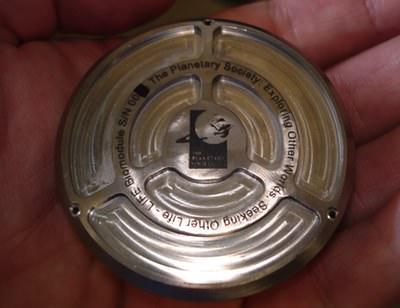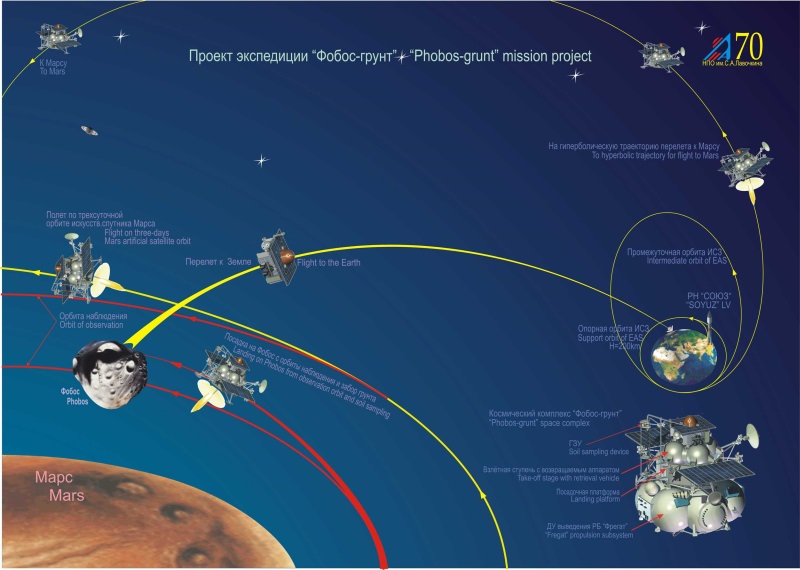[/caption]
Editor’s note: Dr. David Warmflash, principal science lead for the US team from the LIFE experiment on board the Phobos-Grunt spacecraft, provides an update for Universe Today on the likelihood of saving the mission.
If communication with Russia’s troubled Phobos-Grunt is not established by November 21, the window for a trajectory to the Martian moon Phobos, will close, experts say. But this would not mean that the spacecraft could not travel to a different destination. In a statement published earlier today by the news and information agency Ria Novosti, Russian space expert Igor Lisov suggested that Phobos-Grunt could be sent to orbit the Moon – Earth’s Moon, that is – or may be even an asteroid, if communication is restored at any point before the 13-ton probe re-enters Earth’s atmosphere.
Evolution of Phobos-Grunt’s Orbit
Boosted into space by a Zenit 2 rocket last week, Phobos-Grunt entered into a low parking orbit, where she was supposed to wait only for 2.5 hours before the next booster stage, Fregat, would send her to a higher orbit and then on to Mars. Because the Fregat engine did not ignite, Grunt still orbits just above our heads. “Highly elliptical, with an initial altitude of 347 kilometers at apogee (the high point) and 207 kilometers at perigee (the low point), the orbit initially was predicted to decay by late November, causing the spacecraft to reenter the atmosphere and burn up. But while the apogee has been decreasing (down to 326 km today), the perigee actually has been increasing by about 0.5 kilometers per day (up to 210.2 km today), due to periodic maneuvering by way of the probe’s small thrusters. After it was realized that the first maneuvering episode had improved the orbit, the predicted reentry date was adjusted to mid January, and if the thrusting episodes continue we can expect the date of the probe’s demise to be moved back still more.

Time for Trajectory to Phobos is Running Out
The improved orbit gives controllers at the Russian Space Agency, Roscosmos, several weeks –even more, if the perigee continues to get higher– to restore communication with Phobos-Grunt, allowing for the uploading of new commands. But, even if control is restored, a flight to Mars and Phobos will not be possible after Monday, November 21st, Lisov explained. Although the Fregat stage is loaded with fuel, to reach Mars, given Grunt’s orbit around Earth and the alignment between Earth and Mars after Monday, would require a higher change in velocity –what propulsion specialists call delta v – than the Fregat is capable of producing.
A Consolation Prize
While cautioning that the idea of sending Phobos-Grunt somewhere other than Phobos falls into the realm of wishful thinking, Lisov urged that efforts to reconnect with the spacecraft continue in full force as long as the craft is in space. Despite several failures of lunar missions, the former Soviet space program did succeed in returning samples from the lunar surface to Earth in the 1970s. Thus, re-purposing the current mission as “Luna-Grunt” or something of that nature is not likely to have the same appeal as Phobos-Grunt has among Russians. Nor could the Grunt landing craft, designed to scoop a surface sample into a capsule that would return to Earth, even set down on the lunar surface. But other components of the science payload might be useful. Though built to observe Mars,China’s Yinghuo-1 orbiter might be able to do something interesting from lunar orbit. Instruments that were to remain on the Phobosian surface might be useful as well.
Then, there is the issue of avoiding reentry. Experts at Roscosmos are confident that the many tons of nitrogen teroxide and hydrazine in Grunt’s fuel tanks will burn up high in the atmosphere if the probe reenters. But people around the planet are scared, and thus might prefer that the fuel be used, even for a one-way mission with undefined science objectives. More importantly, achieving in a partial victory by sending the spacecraft anywhere but back to Earth could give rise to an Apollo 13-like milieu that might reinvigorate the Russian planetary program.
Millions of Tiny Passengers

As I’ve discussed in a previous update, to be useful scientifically, the Planetary Society’s Living Interplanetary Flight Experiment (LIFE) rides inside the capsule that was designed to return the Phobosian sample to Earth. The point of the experiment is to test the effects of the space environment on several different types of organisms. Because the Moon orbits Earth far outside the Van Allen radiation belts, the radiation received per time by organisms on lunar flights is the same as that received during flights to Mars. If the capsule could be sent into lunar orbit, our millions of passengers would be like organisms traveling inside a meteoroid from Mars. Then perhaps some future mission could recover the capsule some day, and we could study the organisms, as we planned to do upon their return from Phobos.
A Possible Asteroid Mission
Lisov also speculated about sending the Grunt spacecraft to an asteroid instead of the Moon. Various asteroids travel fairly close to Earth, and it’s plausible that a Grunt probe revived after November 21 would have enough delta v to reach one of them. Unlike Earth’s Moon, whose gravity the Grunt lander was not designed to withstand, many asteroids are small. Theoretically, Grunt’s lander could set down on any celestial body with a gravitational force similar to that of Phobos. If any such asteroid candidate exists –and this is a big if– the ascent engine, designed to propel the Grunt return capsule back to Earth might be utilized to deliver a sample of the asteroid, along with the LIFE experiment.


Good article, but — apogee is the high point; perigee is the low point.
If Fobo-Grunt could be contacted the _real_ scoop would be to target Earth’s trojan and get there before anyone else to observe and perhaps collect samples of the only _known_ trojan of Earth. That would be a science project worth accomplishing.
I forgot about that one, thanks! That seems to be 2010 TK7.
Unfortunately it places as #6435 on Pasi Jokela’s link ordering ease of NEO reach, at some ~ 1.5 of the delta-v needed to get to Mars. Dunno what reserves P-G has, but it can’t be ~ 50-60 % I would think.
But we will have to wait and see. It is a good suggestion in any case! Even if those Trojans would be temporary at a guess, they would mean more public outreach.
Check out this table: http://echo.jpl.nasa.gov/~lance/delta_v/delta_v.rendezvous.html
It seems to indicate that with the Mars rendezvous delta-v budget you could reach nearly 2000 known NEOs. Of course you’d want to choose one that is as interesting as possible, allows for the landing and sample collection, AND the return to Earth trajectory for the sample return capsule.
It wouldn’t be quite as nice as going to Phobos but I’m sure heck of a lot of scientists would be thrilled anyways!
That would be nice! It was a bummer to see the original mission start to fail already at the first parking orbit.
is it just me or does anyone else notice that Russian space tech recently seems to have deteriorated and become rather unreliable…
seeing their only ones with active, human rated, launcher I would argue their technology is sound.
The bigger problem with why they can’t communicate with the probe is outlined here. Mismanagement and lack of communication & tracking systems to support the mission seem to strike at the heart of the problem.
It would appear they launched without any redundancy or weren’t able to fund it to that extent.
http://www.russianspaceweb.com/phobos_grunt_kik.html
If not Phobos after November 21st, then why not Deimos? Would that require less Delta-V to reach?
The problem is that Mars is too far away after the 21st I think, so Deimos would be out too.
I LIKE recycling things. ~*~
When he say ‘delta v’ does he mean change in velocity? I’m not sure how to put the Greek letter delta up here, but why not stop trying to sound smarter than us and just say change in velocity.
When you say “velocity” do you mean speed in a particular direction? Why not stop trying to sound smarter than us and just say speed in a particular direction.
Not wanting to be Debbie Downer here but all of this is just wishful thinking in the absence of any communication to/from Phobos-Grunt. And it is my understanding that we are not receiving telemetry from the craft and there’s no indication it’s receiving or acting on any instructions sent to it.
What I’m curious about is if the craft continues to adjust it’s orbit how long can it stay up with the fuel it has? Assuming that it continues to maneuver to stay at around the height it is now.